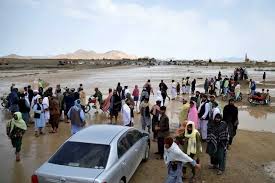Kabul (Arabnews): Extreme rainfall in Afghanistan and devastating flash floods have killed at least 66 people and damaged homes, infrastructure, and farmlands across most of the country’s provinces, authorities said on Tuesday.
The storms, which started over the weekend, are adding to the challenges facing Afghanistan, which is still recovering from decades of conflict and natural disasters, including unprecedented droughts in the past four years, as well as a series of deadly earthquakes.
“According to primary reports from the provinces, at least 66 people lost their lives, and 36 others are injured,” Janan Sayeq, spokesperson of the National Disaster Management Authority, told Arab News on Tuesday.
The number of reported casualties has doubled since Sunday, raising fears the actual toll could be higher. Many of the victims were killed when their homes collapsed on them.
Sayeq said that 1,235 houses were destroyed.
Flash floods were reported in 23 of the country’s 34 provinces, damaging crops ahead of the harvest season, and further affecting food security in the country as UN agencies estimate that more than half of its population has been in need of humanitarian assistance.
“The wheat crops will be ready for collection in a few weeks. But the rainfalls could destroy most of it,” said Gul Hussain, a farmer from the eastern Laghman province, which is one of the main agricultural regions.
The impact of drought, and now also floods, has been devastating for rural families struggling with access to water.
“The floods have had severe effects on the lives of people in the southeast, southwest and east of the country and have caused loss of life and damage to houses, as well as economic and agricultural effects as crops are destroyed and livestock are killed,” Najibullah Sadid, a hydromophologist, told Arab News.
The country’s mountainous topography and reduced vegetation left little to no space for people to escape flood events, as preparedness and prevention in the face of the changing climate are almost nonexistent.
Water management infrastructure — such as check dams, trenches, terraces, and reservoirs that could help reduce flooding — is insufficient.
“For instance, Afghanistan has 22 percent less water storage compared to Iran and 13 percent less compared to Pakistan, making the country more vulnerable to floods during rainfalls,” Sadid said.
“Considering the increasing climate change effects as well as frequency and intensity of rainfalls, steps taken during the past two decades and now are limited and are not sufficient to control the situation.”







